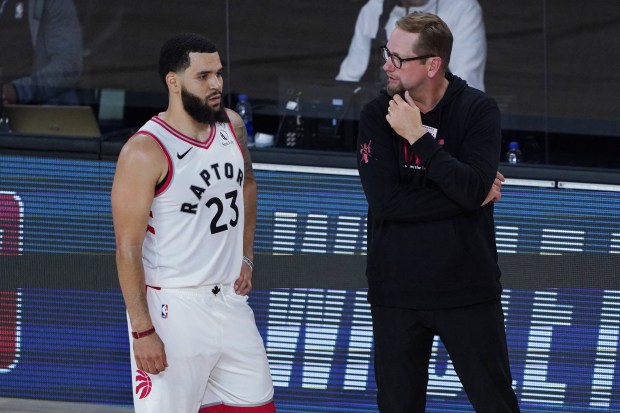LAKE BUENA VISTA, Fla. — Nick Nurse is one of the leading contenders for NBA coach of the year, respected by his peers for his deep knowledge of a variety of unconventional schemes and a game willingness to use them.
But an hour before he was to take on the No. 1 Western team, Nurse still wasn’t clear on one elementary detail: “Who’s home tonight, anyway? Us?”
It’s the kind of thing that’s only ever unclear in the NBA bubble, where “home” and “away” have little meaning to games played in one of three venues all at ESPN Wide World of Sports at Disney World.

The Lakers and Raptors, two teams with vivacious home crowds and a combined 48-17 records at home, are among those still trying to figure out what value being a “home team” has.
In Saturday’s game between the Lakers and Raptors, 17-foot digital screens displayed Raptors logos and played game-op designed videos. Team introductions were recorded by Raptors’ public address announcers, wrapping up with an iconic trill: “KYLE L-L-L-L-LOWRY.”
Virtual fans sat in a few hundred seats, and artificial crowd noise oohed and aahed with Raptors highlights instead of Lakers ones.
But beyond what is on the digital screens, the actual screens themselves are the same in every venue. No matter how many digital fans are watching, the real audience is typically two hundred-odd people whose reactions are muted at best. The courts are the same, too, and even though some of them are digitally altered on team broadcasts to add logos, the general design for every aspect is minimalist.
As much as the NBA will try to make home court matter, it simply isn’t the same — something that’s on the mind of the Lakers as they close in on “home court advantage” throughout the Western Conference playoffs.
“Clinching the one seed, is there an advantage here?” LeBron James said Saturday, when asked about the priorities for the remaining six seeding games. “There’s not much of a home court advantage here. But we worked hard to be the No. 1 team in the West … we got this far, so we might as well try to figure it out and close it off the right way.”
The Lakers themselves have recorded longtime PA man Lawrence Tanter for their intros and a handful of other calls, and the NBA has instructed in-house PAs to vocalize differently for home and road teams.
In the first two games the Lakers played, The Arena host was Olivier Sendra, a Brooklyn Nets announcer who covered both of James’ stints in Cleveland. The Lakers also brought a handful of well-known fans on their digital attendance rolls: On Thursday, the virtual crowd included Gary Zelman, known more popularly as “the Sign Guy.” Other teams have had mascots sitting in digital seats.
But an empty house is an empty house. The Lakers have said that the circumstances haven’t affected them: Neither the black background to the stanchion when they shoot, nor the lack of crowd noise. While players have said they prefer playing to crowds, they also have talked about “locking in” during the game action itself, trying to concentrate on what’s going on inside the lines.
“It makes no difference to me,” Anthony Davis said. “Before the hiatus, I would still, even in Staples, or on the road in someone else’s arena, I would always just focus on the floor. I don’t hear anything outside of that. So this is kind of what I play through all the time. There’s nothing new for me personally.”
That hasn’t stopped a little bit of fun: Quinn Cook and JaVale McGee are among those who pantomime playing to the crowd when the Lakers run in for their lay-up line, putting their hands to their ears and gesturing for the imaginary audience to get loud.
Backup ball-handler still a hole
From “quarterback” to “floor general,” every playmaking cliche in the book has been used to describe Rajon Rondo’s influence on the court. But the best picture of what Rondo brings might be how the Lakers are still searching for someone to fill his role as a backup ball-handler to LeBron James.
During a critical fourth-quarter stretch as the Raptors went on a 21-5 run, the Lakers turned to Alex Caruso. The 26-year-old had a strong game on the whole, finishing with 11 points, three steals and a plus-two rating, but threw three turnovers during a three-minute span. It included a Hail Mary pass to Anthony Davis, an errant pass to a defender, and losing the ball as he drove in against Fred Van Vleet. As a team the Lakers had the same number of turnovers (17) as assists.
Vogel said one of his biggest goals of the remaining six seeding games is to get Kentavious Caldwell-Pope and Caruso adjusted to bigger roles in the rotation. While Dion Waiters provides a needed scoring punch in the backcourt, one of Caruso’s main roles in the second unit is now to be on ball with Rondo out probably through at least the first round of playoffs. Caruso has played point in college and the G League, but his late struggles illustrated where the Lakers still could be vulnerable — although Vogel didn’t hang the turnovers all on him.
“He’s done a good job improving with that throughout most of the year, but like we’ve been talking about he’s looking at potentially a bigger role and he’s going to be in those situations,” Our whole group was a little out of rhythm during that stretch, he had a couple of those turnovers but he’s doing a great job for us on both ends of the floor and he’ll be fine with that.”




